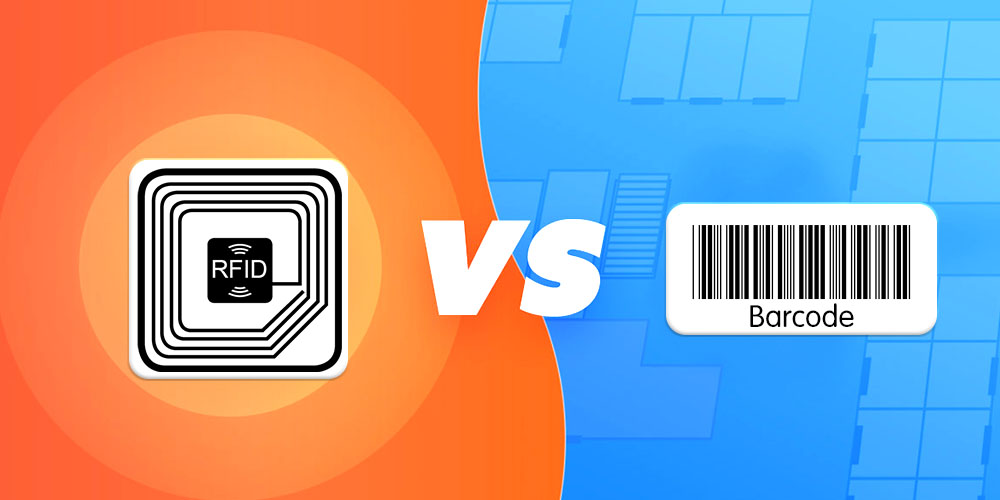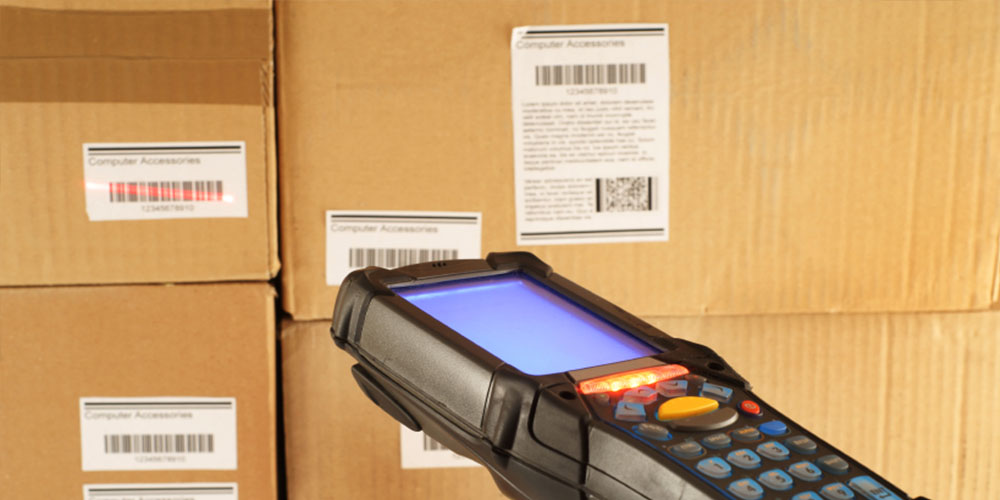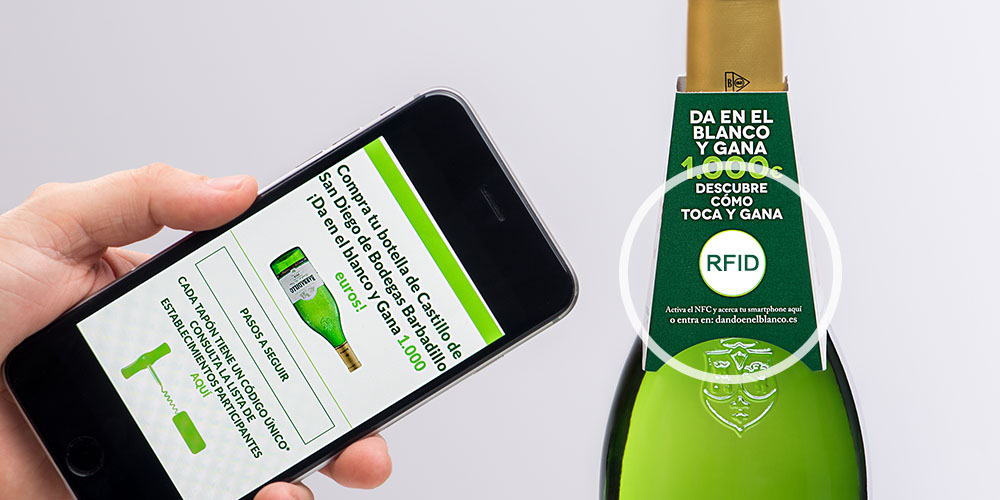When it comes to RFID and barcodes, in the eyes of many people, they are like two brothers with very different personalities, and they are compared from time to time. Objectively speaking, they are two different technologies to achieve identification and tracking quickly and accurately. They have different applications, but sometimes overlap and cooperate. They both have advantages and disadvantages depending on how to use them. Today we are going to make a detailed comparison between RFID and barcodes to give you a better idea of what they are and how to choose.

What is Barcode?
The barcode is a graphic identifier that represents a set of information by arranging black bars and white spaces of different widths according to certain coding rules. And you can obtain this information by a laser scanner. At present, the common ones are one-dimensional barcode and two-dimensional barcode.
Barcode is an automatic recognition technology that integrates the functions of symbol coding, data collection, automatic identification, information entry, and information storage into one. It can effectively solve the problems of a large amount of data collection and automatic input in the logistics process.
What is RFID?
RFID is a wireless communication technology that can identify specific targets and read and write relevant data through radio signals without the need to establish mechanical or optical contact between the identification system and specific targets. The radio signal transmits the data from the label attached to the object through the electromagnetic field tuned to the radio frequency to automatically identify and track the object.
The basic RFID system consists of an RFID tag, reader, and RFID antenna. RFID can read and write information within the scope of the reader.
Barcode Advantage and Disadvantage
Barcode is the most economical and practical automatic identification technology and known as the common language of the international market of goods. It can indicate the country of production, manufacturer, product name, production date, book classification number, starting and ending location of mail, category, date, etc.

Barcode is a passport for goods to enter the international market. At present, it is widely used in commerce, books management, postal management, warehouse management, banking system, industry, agriculture, transportation, and other fields, and still occupies an important position in today’s commodity management.
Advantages of Barcode
- Fast information acquisition speed:Barcode input is five times faster than keyboard input and allows for real-time data input.
- High Reliability:The error rate of keyboard input data is 1%, the error rate of optical character recognition technology is 1%, and the error rate of barcode technology is less than 1%.
- Large amounts of information:The traditional one-dimensional bar code can collect dozens of characters at a time, and the two-dimensional bar code can carry thousands of characters. Besides, it has the ability to automatic error correction.
- Flexible and practical: Barcode system equipment is low cost. Barcode can be used alone as one of identification means, and it can achieve automatic identification combined with identification equipment. Besides, with control equipment, it can realize automatic management.
- Easy to operate:The barcode symbol recognition equipment has the advantages of simple structure. It is easy to operate and does not require special training.
- Easy to make:It is called printable computer language. Barcodes are easy to make and have no special requirements for printing technical equipment and materials.
Disadvantages of Barcode
- Bar code is generally composed of manufacturer code, commodity code, check code, and so on, so bar code technology can only identify limited information such as producers and commodities.
- When the bar code label is damaged, contaminated, or falling off, the scanner cannot identify the target.
- Barcode label information is easy to be copied.
- The bar code cannot change the memory.
- The bar code based on optical technology can only be recognized in the range of short-range straight rays received by the scanner.
RFID Advantage and Disadvantage
RFID is an emerging technology, but it has attracted much attention because of its long-distance reading and high storage capacity. It is widely used in many industries and fields, such as logistics, transportation, identification, anti-counterfeiting, asset management, food management, safety control, etc.

Advantages of RFID
- Strong Anti-fouling Ability. RFID uses electronic chips to store information, which can be protected from external environmental pollution and is highly resistant to substances such as water, oil, and chemicals.
- High Security. RFID tags use electronic chips to store information, and its data can be protected by encoding, and its content is not easy to be forged and changed.
- Large Capacity. One-dimensional barcode has limited capacity, and two-dimensional barcode maximum capacity can only store 3000 characters. The capacity of RFID tags can be dozens of times of the two-dimensional barcode capacity. Besides, RFID can realize one thing one code to meet the needs of the increasing amount of information.
- Identify Multiple Tags Simultaneously. The bar code can only be scanned one at a time and is required to be close to the reader. RFID uses radio waves to exchange data, and RFID readers can identify multiple RFID tags at the same time over a long distance and can process and transmit information through the computer network.
- Miniaturization and Diversified Shapes. RFID is not limited by size and shape in reading and does not need to match the fixed size and printing quality of paper for reading accuracy. Besides, RFID tags can be miniaturized and developed in various forms to meet different applications.
- Reusable and Durable. RFID tags can repeatedly add, modify, and delete the data stored in the tags, which is easy to update information. And the RFID tag has a long service life of up to 10 years.
- Strong Penetration. When covered, RFID can penetrate non-metallic or non-transparent materials such as paper, wood, and plastic, and can communicate transparently.
Disadvantages of RFID
- High Cost: Establish an RFID system is a high cost. The equipment including RFID transmitters, RFID readers, RFID encoders, and antennas are relatively expensive.
- Privacy Issues:Once the RFID tag gets close to the reader, it will automatically send a message unconditionally. It is impossible to confirm whether the RFID reader is legal. For example, in People’s Daily objects, the owner of the item (such as clothing) may not be aware that the item has been embedded with electronic tags and maybe scanned, located and tracked without control, which will inevitably lead to the invasion of personal privacy.
- Frequency Inconsistency:The open frequency bands are different in different countries, and there is still a problem of consistency.
- Insufficient Technology Maturity:RFID technology has a short history and is not very mature in technology.
RFID VS Barcode: Top 10 Differences
Barcode technology and RFID technology are known as the identity cards of items in the Era of Internet of Things because they can be used to store information of items, which can represent the identity of an item to a certain extent. However, RFID, as the unique identity of an item, can store more information. Moreover, there are many differences between them.
Comparison of RFID tags with traditional bar codes
| Identification Method | RFID Tag | Barcode |
| Recognition Principle | Radio frequency signal | Photoelectric effect |
| Identify Object | A single concrete object | A class of objects |
| Recognition Range | Up to 100cm | Close |
| Penetrability | YES | NO |
| Recognition Speed | Fast: Multiple objects can be identified simultaneously | Slow:Object-by-object recognition |
| Information Content | Large and updatable | Small and not renewable |
| Use Environment | Waterproof and corrosion resistant | Not waterproof, not resistant to corrosion |
| Manufacturing Cost | High | Low |
| Supporting Equipment | High Cost | Low Cost |
1、 Different Principles
A bar code is a graphic identifier that represents a set of information by arranging black bars and white spaces of different widths according to certain coding rules. The principle of RFID is the non-contact data communication between the reader and tag to achieve the purpose of identifying the target.
2、 Read Distance
Bar codes only support close range reading, so barcode readers need to read the printed barcodes at close range; RFID tags support further reading distance, whether active RFID tags or passive RFID tags. Besides, RFID can read through paper, wood, and plastic, but bar codes cannot.
3、 Different Applications
Barcode is mainly used in commodity circulation, book management, postal management, banking system, and other fields; RFID is more widely used. The typical applications are animal management, access control, parking control, production line automation, asset management, laundry management, event management, etc.
4、Different Storage Capacity
One-dimensional bar codes have a capacity of 50 bytes, two-dimensional bar codes have a maximum capacity of 2 to 3000 characters, and RFID has a maximum capacity of several megabytes.
5、Different Scanning Efficiency
Barcode scanning recognition frequency is limited. Only one barcode can be scanned at a time; RFID reader can identify and read several RFID tags at the same time.
6、 Read and Write Function
Bar code does not have read and write function, and information cannot be added on the printed bar code; RFID tags can be read and written. RFID readers can communicate with the tags and modify the stored information to the extent allowed by the tag design.
7、External Appearance
RFID is not limited by size and shape in reading and does not need to solve the size of carrier or printing accuracy for reading accuracy. Besides, RFID tags can be further miniaturized and diversified forms of development, to be applied to different products.
8、 Safety Performance
RFID data can be protected by encryption technology that is not easy to be forged and altered; The information of barcode is exposed, and it usually uses common coding rules so that data security cannot be guaranteed.
9、 Service Life
The carrier of the traditional bar code is paper, so it is easy to be contaminated and damaged. And the bar code cannot be changed and cannot be reused after printing; RFID stores the data in the chip to avoid stain, and can repeatedly add, modify and delete the data stored in the RFID tag, resulting in longer service life.
10、Cost
The barcode system is the most economical and practical automatic identification technology at present because of its flexible configuration and low cost. Although the RFID system has many irreplaceable advantages, it is much higher than the barcode in manufacturing cost and equipment cost, which has become the main obstacle to the wide use of RFID.
Conclusion
The biggest difference between RFID and barcode is that RFID has a chip. RFID tags can be made into a variety of different shapes and sizes, able to attach to different carriers. Through the RFID chip, we can not only write the information and update the memory information but also encrypt the information with high security. The barcode cannot be written and changed again, once it is scratched, stained, or peeled off, the scanner will not be able to identify the information, and the security is relatively low.
RFID also has more advantages in information recognition. Because the information of RFID is transmitted through radio waves and has penetration, its reader does not need a visible light source, can read the information directly through the outside. And it can process the information on multiple RFID chips at the same time to achieve higher work efficiency.
The information of the barcode must be scanned and identified one by one through the laser scanner, which is not only troublesome but also easy to make mistakes, which is greatly affected by environmental conditions, and the efficiency is relatively low.
Nowadays, because the barcode technology is relatively more mature, the cost is lower than RFID, and it has been used in the market for a longer time with a perfect standard system, so it has penetrated our daily life and work. But in the long run, RFID will be more widely used in more industries with its many advantages. With the continuous development of information technology and the gradual reduction of the cost of RFID, the future of RFID is bright.







Nice post. I learn something totally new and challenging on websites
I appreciate your work for providing us such a useful information.it was really good content. This is very innovative and informative also useful Article. Very good article on latest trending topics. This is one of the most incredible blogs I’ve read in a very long time.